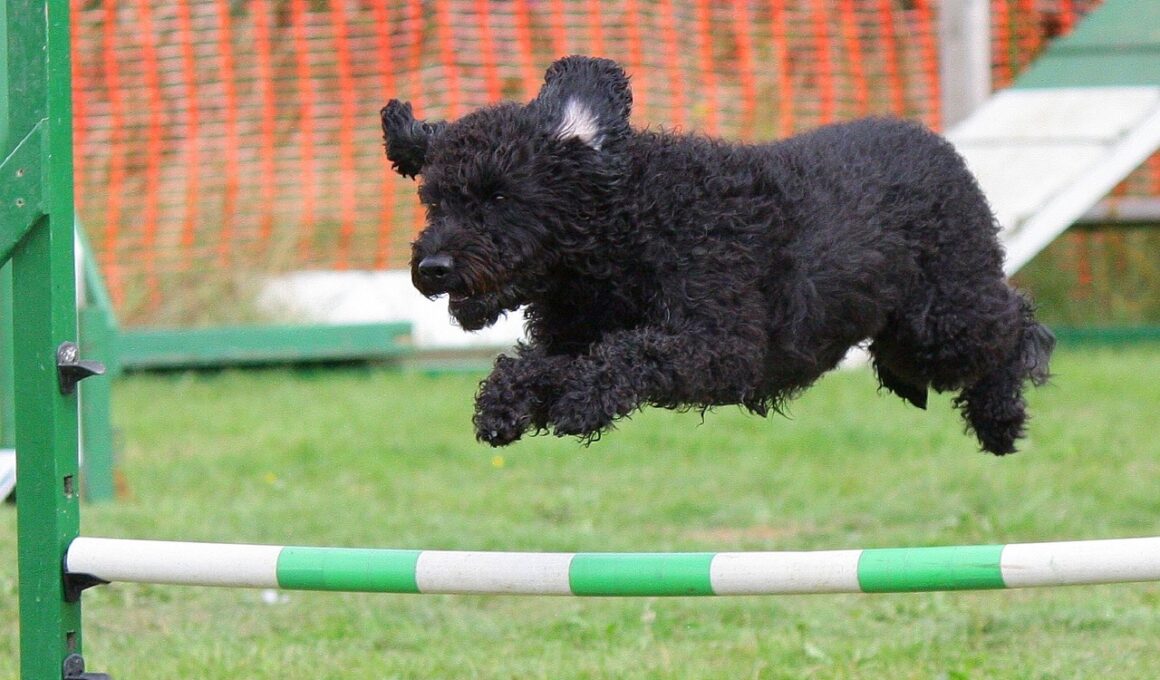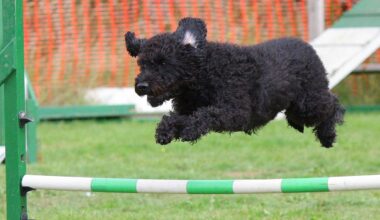Choosing the Right Equipment for Dog Agility Training
Dog agility training is essential for developing a solid bond with your canine companion. When selecting equipment for agility, consider your dog’s size and skill level. Begin with basic tools such as tunnels and jumps, which are accessible for beginners. Using lightweight and adjustable equipment is crucial, as it allows for easier modifications for training sessions. Evaluate the materials of the equipment because durable materials withstand the rigorous activity of agility training. It’s recommended to look for PVC for jumps and heavy-duty fabrics for tunnels. Additionally, investing in high-quality contact equipment is vital for ensuring the safety of your dog. Accidental injuries can stem from poorly designed gear, so choosing equipment specifically made for agility courses will help minimize risks. Furthermore, remember that agility equipment should suit your environment whether you practice indoors or outdoors. Rain and moisture can affect certain materials, so being mindful is important. Ultimately, prioritize your dog’s comfort and safety over aesthetics. With the right equipment, you’re on your way to successful agility training that strengthens your bond with your furry friend.
Essential Agility Gear
Agility gear is more than just fun; it’s foundational for competitive training. The most crucial piece of equipment is the jump, which helps improve your dog’s jumping ability and coordination. Choose adjustable jumps to accommodate different heights to match your dog’s skill progression. Next, consider the tunnel; it enhances your dog’s confidence in navigating through obstacles. An open-ended tunnel can be beneficial for beginners, allowing your dog to approach it with less hesitation. Weave poles are another important element, incredibly useful in developing your dog’s agility skills. These poles can be spaced according to your dog’s ability, ensuring a gradual learning curve. Remember to incorporate a pause table; this provides a surface where your dog can learn to stabilize and prepare for further tasks. Each piece of equipment plays a role in telling your dog what to expect and how to navigate. Also, invest in a good quality set of safety mats to cushion falls resulting from miscalculations. Prioritize quality over cost for your dog’s agility kit and take the time to train effectively using these tools. Your commitment reflects in your dog’s progress and performance, creating an amazing dynamic between you both.
Another critical factor in dog agility equipment is portability. If you’re training in multiple locations, choose lightweight gear that can be easily transported. For instance, pop-up tunnels and collapsible jumps fit well in cars and can be set up quickly. Depending on your preference, some agility gear can even be folded flat to save space. In addition, consider weather-resistant gear if you plan to train outdoors frequently. Equipment exposed to the elements should be durable enough to withstand varying conditions, ensuring its longevity. Purchasing gear with weather-resistant features means less worry about damage from rain or sun exposure. Also, don’t forget about training lead and collar customization that provides additional support during agility runs. This should be lightweight yet strong enough to withstand enthusiasm while running through the course. Additionally, consider a noise-free leash, which can reduce distractions and improve focus during training sessions. Each component, no matter how small, will contribute to the overall agility experience for your dog, allowing you to build confidence together. Choose wisely, and you’ll create a supportive training environment that promotes growth in agility skills.
When you begin to choose equipment for dog agility, think about how they motivate your dog. Specialized toys designed to spark interest can substantially improve your training sessions. Utilizing these toys allows for rewards that encourage your dog to try and succeed through the course. It’s also crucial to develop a routine that includes regular training schedules with your dog. Incorporating agility equipment into your training routine will help establish expectations and reinforce good behavior. Furthermore, always monitor your dog for signs of fatigue or disinterest, as this will inform you if adjustments are necessary to the training style or duration. Having activity and small breaks are opportunities to refresh and maintain motivation. Also, familiarize yourself with agility training techniques by following experts or trainers. Online resources, books, and videos are abundant, and they can provide insight into different training methods. If possible, attend local agility classes to gain hands-on experience while learning directly from professionals. Exploring these avenues deepens your understanding and further improves your communication with your dog, enhancing both your training sessions and agility performance.
Choosing Between DIY and Store-Bought Equipment
Many dog owners question whether to buy or build their own agility equipment. DIY agility gear can be a cost-effective solution if you possess the right skills and tools. Create jumps and tunnels using PVC pipes or other materials; loading videos online can provide guidance on construction. However, you need to ensure that every piece remains safe and sturdy for your dog’s use. Alternatively, buying pre-made equipment can save time and often comes with a warranty, ensuring you have a reliable product. Weighing the pros and cons depends on your skill level and how serious you are about agility training. If you are just starting out, investing in professional-grade gear may be worthwhile, particularly as your dog progresses to higher levels of agility challenges. Store-bought gear often adheres to safety guidelines, ensuring a secure experience for your dog. Regardless of the choice, incorporating quality materials is key. Ensure that the equipment aligns perfectly with your training needs and initiatives. Though it may seem less exciting, reliability and safety should always remain priorities when selecting equipment.
Participation in competitions is another factor to weigh in your equipment selection. Typically, competition organizations have specific rules and requirements for gear used, which often differ from training equipment. Therefore, it’s wise to research these standards to ensure you’re training with the right type of gear. This helps familiarize your dog with competitive equipment and scenarios, benefiting performance on the day of the competition. Furthermore, understanding these standards can save you from needing to purchase multiple types of equipment later on. In addition to equipment, you should focus on conditioning exercises that help build agility. Engaging your dog in cross-training activities, like fetch or swimming, can improve stamina and overall health. Building strong core muscles helps your dog tackle agility courses more effectively, maximizing performance when it matters most. Remember the importance of balance; too much focus on equipment can sideline key physical improvements your dog needs. Striking a balance between quality equipment and physical fitness is crucial for creating a successful path towards mastering agility training.
Finally, never overlook maintenance and care for your agility equipment. Regular inspection and upkeep are essential to ensure everything remains functional and safe for your dog. Check for cracks, loose fittings and clean surfaces regularly. Regular care extends the life of your equipment while reducing the risks of injury during training sessions. Also, store equipment in a secure way; placing it in protective cases can reduce exposure to harsh elements. When not in use, items like tunnels can be stored away from sunlight to prevent material degradation. Investing time in maintenance may result in substantial savings over time, avoiding the cost of frequent replacements. Teach your dog to respect agility equipment; this reduces wear and tear. Involve them in the setup process, creating a sense of ownership and pride. Practicing responsible equipment ownership reflects your commitment to agility training, strengthening your partnership with your dog. As you and your furry friend embark on this exciting journey together, prioritize safety and fun as your guiding principles through every training session.


